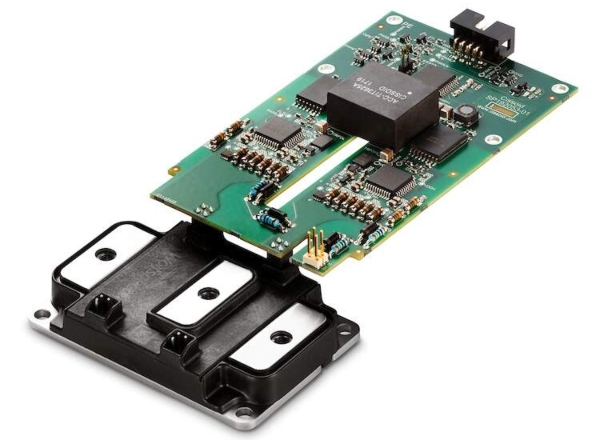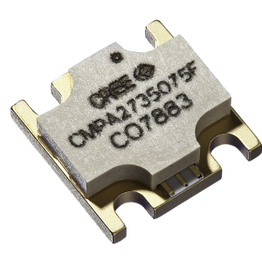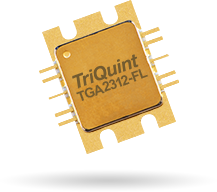Gallium nitride (GaN) is a wide bandgap material that offers significant advantages in high-power radio frequency (RF) applications. Compared to traditional semiconductors (such as silicon), gallium nitride has some very important physical and electrical properties, including:
- high breakdown voltage;
- high power density;
- high operating and switching frequency;
- high efficiency;
- excellent thermal conductivity.
Compared to traditional technologies, gallium nitride has proven to be a superior material for several applications in the radio frequency field, where reliability, efficiency and reduced absorption are essential requirements. During the manufacturing process, gallium nitride is usually grown, at temperatures above 1000 °C, on a substrate composed of silicon carbide (SiC) in the case of RF applications, or of regular silicon in the case of power applications. Technology based on GaN-on-SiC is by far the most used, both because it combines the high-power density of gallium nitride with the low power losses of silicon carbide, and because it solves the issues related to thermal management and parasitic losses. GaN-on-Si technology, despite having a lower cost, entails worse thermal performances and higher losses of RF signal power.
RF applications of GaN
Although gallium nitride is often associated with classic RF applications, such as power amplifiers (PA), there are numerous other significant applications of this innovative material. The ever-increasing levels of power and efficiency achieved by these devices are making them attractive, particularly in applications in the space and military sector (especially for military grade radars). Robustness, excellent thermal performances, reduced weight and dimensions, allow this material to be a better choice on other types of competing technologies even in low frequency RF applications. In military radars, when operating on frequency bands of different gigahertz, gallium nitride has proven to be the ideal solution for making solid state transmitters, replacing legacy technology based on klystron tubes. The latest generation military radars, operating with electronically scanned arrays (AESAs) and phased array modules, will greatly benefit from the availability of GaN-on-SiC based monolithic microwave integrated circuits (MMICs). The applications of GaN technology are not limited, however, to the space sector and military radar. In the field of telecommunications, with mobile telephony in particular, this material is used to create various innovative solutions, such as those which underpin 5G technology. Gallium nitride-based components are progressively replacing traditional silicon-based ones in specific applications such as RF amplifiers and phased antenna arrays. The superior characteristics of GaN prove to ideal for an efficient management of both the sub-6-GHz band and the one above 20 GHz (millimeter waves, or mmWave). To meet the stringent requirements of the 5G network (fast data rate, large scale broadband and low latency), innovative technologies such as GaN, which are capable of operating at high frequencies (28 GHz and 39 GHz), are needed as they reduce the size of the receiving antennas as much as possible.
GaN RF devices
Wolfspeed has a wide portfolio of GaN-based power devices, such as the CMPA2735075F, a 75-W, 2.7 – 3.5-GHz, GaN MMIC Power Amplifier. The device, shown in Figure 1, is a gallium-nitride (GaN) HEMT-based monolithic microwave integrated circuit (MMIC). Due to the superior properties of GaN compared to silicon or gallium arsenide, including higher breakdown voltage, higher saturated electron drift velocity and higher thermal conductivity, the device is particularly suitable for S-band (2.0 – 4.0 GHz) civil and military pulsed radar amplifiers. GaN HEMTs also offer greater power density and wider bandwidths compared to Si and GaAs transistors. This MMIC contains a two-stage reactively matched amplifier design approach enabling very wide bandwidths to be achieved. This MMIC enables extremely wide bandwidths to be achieved in a small-footprint, screw-down package.
MACOM, a leading designer and manufacturer of semiconductor devices for telecommunication, data center, industrial and defense applications, has a wide selection of RF power products. An example is the MAGx-011086, a GaN on silicon carbide general purpose HEMT amplifier, optimized for DC – 6 GHz operation in a user friendly package ideal for high bandwidth applications. The device has been designed for saturated and linear operation with output power levels of 4 W (36 dBm) in an industry standard, low inductance, surface mount QFN package. The pads of the package form a coplanar launch that naturally absorbs lead parasitics and features a small PCB outline for space constrained applications. Using state of the art wafer fabrication processes, MAGx transistors provide high gain, efficiency, bandwidth, and ruggedness over a wide bandwidth for today’s demanding application needs such as pulsed avionics and radar applications.
Qorvo, a semiconductor company specialized in radio frequency systems, has a proven track record in providing power amplifier (PA) solutions across many frequency and power levels. The TGA2312-FL, shown in Figure 2, is a high power amplifier operating between 9 and 10 GHz and typically providing 48 dBm of saturated output power, 38% power-added efficiency, and 13 dB small signal gain. Ideally suited for marine and weather radar, the TGA2312-FL is packaged in a CuW-base, flanged package for superior thermal management. The TGA2312-FL uses Qorvo’s 0.25um GaN on SiC technology, which provides superior performance while maintaining high reliability. In addition, the use of SiC substrates provides optimum thermal performance necessary for reliable high-power operation.




